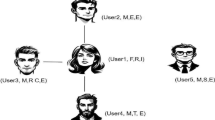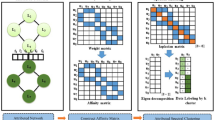Abstract
The maximum likelihood estimation is a probabilistic inferencing model of community connectivity in large networks. In general, only the adjacency matrix is utilized to perform community structure parameter inference. Although there are recent examples that combine connectivity and attribute information for community detection, our model is an enhanced overlapping community detection model that combines adjacency spectral embedding with maximum likelihood estimation. This provides the flexibility of complex networks to increase connectivity information through measurements from attribute embedding. The attribute information can be effectively captured and transformed by attribute embedding to encode the combination with structure information. Then, the link strength among communities is designed to adjust the impact of these structural information on community generation based on the contribution of the structure to the clusters, and the node assignment allow for the nature of the real network (overlapping and outliers). Experiments highlight attributed networks in which attributed community detection task provides satisfactory performance.






Similar content being viewed by others
Notes
Throughout text, we use the words {{nodes, vertices, objects}, {characteristic, intuition, nature, property}, {circles, cluster, communities}} interchangeably.
References
Peng C, Zhang Z, Wong KC et al (2017) A scalable community detection algorithm for large graphs using stochastic block models. Intell Data Anal 21(6):1463–1485
Yang J, McAuley J, Leskovec J (2013) Community detection in networks with node attributes. IEEE 13th international conference on data mining. IEEE, 2013 pp 1151–1156
Zhang F, Zhang Y, Qin L et al (2016) When engagement meets similarity: efficient (k, r)-core computation on social networks[J]. arXiv preprint arXiv:611.03254.
Whang JJ, Gleich DF, Dhillon IS (2016) Overlapping community detection using neighborhood-inflated seed expansion. IEEE Trans Knowl Data Eng 28(5):1272–1284
Yang J, Leskovec J (2013) Overlapping community detection at scale: a nonnegative matrix factorization approach. Proceedings of the sixth ACM international conference on web search and data mining. 2013:587–596
You X, Ma Y, Liu Z (2020) A three-stage algorithm on community detection in social networks. Knowl-Based Syst 187:104822
Pan X, Xu G, Wang B et al (2019) A novel community detection algorithm based on local similarity of clustering coefficient in social networks. IEEE Access 7:121586–121598
Li J, Kumar CA, Mei C et al (2017) Comparison of reduction in formal decision contexts. Int J Approximate Reasoning 80:100–122
Xia S, Zhang Z, Li W et al (2020) GBNRS: a novel rough set algorithm for fast adaptive attribute reduction in classification. IEEE Trans Knowl Data Eng pp 1–1
Zhang H, Wang CD, Lai JH et al (2019) Community detection using multilayer edge mixture model. Knowl Inform Syst 60(2):757–779
Whang JJ, Hou Y, Gleich DF et al (2018) Non-exhaustive, overlapping clustering. IEEE trans pattern anal mach intell 41(11):2644–2659
Xia S, Peng D, Meng D et al (2020) A fast adaptive k-means with no bounds. IEEE Trans Pattern Anal Mach Intell 1–1
Xia S, Chen B, Wang G et al (2021) mCRF and mRD: two classification methods based on a novel multiclass label noise filtering learning framework. IEEE Trans Neural Networks Learn Syst 1–15
Xia S, Liu Y, Ding X et al (2019) Granular ball computing classifiers for efficient, scalable and robust learning. Inform Sci 483:136–152
Liu Z, Xiang B, Guo W et al (2019) Overlapping community detection algorithm based on coarsening and local overlapping modularity. IEEE Access 7:57943–57955
Zhe C, Sun A, Xiao X (2019) Community detection on large complex attribute network. Proceedings of the 25th ACM SIGKDD int conf knowl discov & data min 2041–2049
Krogan NJ, Cagney G, Yu H et al (2006) Global landscape of protein complexes in the yeast Saccharomyces cerevisiae. Nature 440(7084):637–643
Whang JJ, Dhillon IS, Gleich DF (2015) Non-exhaustive, overlapping k-means. Proceedings of the 2015 SIAM international conference on data mining Soc Ind and Appl Math 936–944
Rodríguez CE, Núr̃ez-Antonio G, Escarela G (2020) A Bayesian mixture model for clustering circular data. Comput Statistics Data Anal, 143:106842
Guo X, Su J, Zhou H et al (2019) Community detection based on genetic algorithm using local structural similarity. IEEE Access 7:134583–134600
Ma X, Yang P, Guan S (2019) Overlapping community detection algorithm based on edge strength. IEEE Access 7:126642–126650
Bertsimas D, Nohadani O (2019) Robust maximum likelihood estimation. INFORMS J Comput 31(3):445–458
Sussman DL, Tang M, Fishkind DE et al (2012) A consistent adjacency spectral embedding for stochastic blockmodel graphs. J Am Stat Assoc 107(499):1119–1128
Perozzi B, Akoglu L (2016) Scalable anomaly ranking of attributed neighborhoods. Proceedings of the 2016 SIAM International Conference on Data Mining. Soc Ind Appl Math 207–215
Zhao Q, Ma H, Li X et al (2020) NotMle: community detection in an inference way. 2020 IEEE 32nd International Conference on Tools with Artificial Intelligence (ICTAI). IEEE 736–741
Newman MEJ (2012) Communities, modules and large-scale structure in networks. Nature phys 8(1):25–31
Mehta N, Duke L C, Rai P (2019) Stochastic blockmodels meet graph neural networks. Int Conf Mach Learn. PMLR, 4466–4474
Qiao M, Yu J, Bian W et al (2018) Adapting stochastic block models to power-law degree distributions. IEEE trans cybern, 49(2):626–637
Airoldi E M, Blei DM, Fienberg SE et al (2008) Mixed membership stochastic blockmodels. J mach learn res 9(2008):1981–2014
Cai X, Huang D, Wang CD et al (2020) Spectral clustering by subspace randomization and graph fusion for high-dimensional data. Adv Knowl Discov Data Min 12084:330–342
Zachary WW (1977) An information flow model for conflict and fission in small groups. J anthropol res 33(4):452–473
You X, Ma Y, Liu Z (2020) A three-stage algorithm on community detection in social networks. Knowl-Based Syst 187:104822
Newman MEJ, Clauset A (2016) Structure and inference in annotated networks. Nature communications 7(1):1–11
Arthur D, Vassilvitskii S (2007) k-means++: the advantages of careful seeding. Soc Appl Math 1027–1035
Frénay B, Verleysen M (2013) Classification in the presence of label noise: a survey. IEEE trans neural networks learn syst 25(5):845–869
Xia S, Wang G, Chen Z et al (2019) Complete random forest based class noise filtering learning for improving the generalizability of classifiers. IEEE Trans Knowl Data Eng 31(11):2063–2078
Ruan Y, Fuhry D, Parthasarathy S (2013) Efficient community detection in large networks using content and links. Proceedings of the 22nd int conf World Wide Web 1089–1098
Ahn YY, Bagrow JP, Lehmann S (2010) Link communities reveal multiscale complexity in networks. Nature 466(7307):761–764
Arasteh M, Alizadeh S (2019) A fast divisive community detection algorithm based on edge degree betweenness centrality. Appl Intelli 49(2):689–702
Lancichinetti A, Fortunato S (2009) Benchmarks for testing community detection algorithms on directed and weighted graphs with overlapping communities. Phys Rev E 80(1):016118
Acknowledgements
This work is supported by the National Natural Science Foundation of China (61762078, 61363058, 61966004), Research Fund of Guangxi Key Lab of Multi-source Information Mining and Security (MIMS18-08), Northwest Normal University young teachers research capacity promotion plan (NWNU-LKQN2019-2), Research Fund of Guangxi Key Laboratory of Trusted Software (kx202003), and Gansu Innovation college fund project (2020B-089).
Author information
Authors and Affiliations
Corresponding author
Ethics declarations
Conflict of interest
The authors declare that there is no conflict of interest regarding the publication of this paper.
Additional information
Publisher's Note
Springer Nature remains neutral with regard to jurisdictional claims in published maps and institutional affiliations.
Rights and permissions
About this article
Cite this article
Zhao, Q., Ma, H., Li, X. et al. Is the simple assignment enough? Exploring the interpretability for community detection. Int. J. Mach. Learn. & Cyber. 12, 3463–3474 (2021). https://doi.org/10.1007/s13042-021-01384-8
Received:
Accepted:
Published:
Issue Date:
DOI: https://doi.org/10.1007/s13042-021-01384-8




